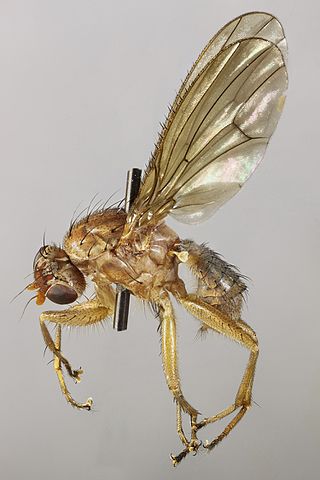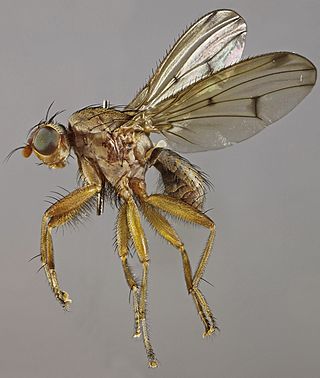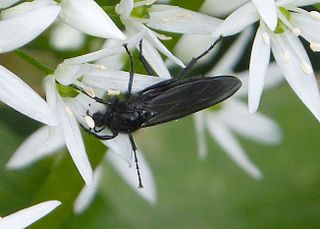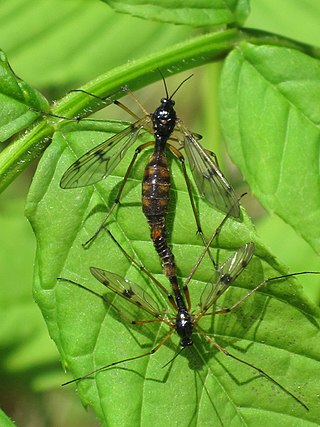The golden otocinclus is one of the smallest known suckermouth catfish, often called a 'dwarf oto'. Endemic to Southeast Brazil, this herbivorous, rheophilic, bottom-feeder only grows to around 4 cm (1.6 in) in length. The close relatives of this small fish are often used for the purpose of controlling algae in small home aquariums, under the name Otocinclus affinis. In reality, they belong to the species O. vittatus, O. vestitus and O. macrospilus and O. huaorani. The real M. affinis is not present in the aquarium hobby.

The black-chested jay is a species of bird in the family Corvidae.

Seioptera vibrans is a species of ulidiid or picture-winged fly in the genus Seioptera of the family Ulidiidae.

Ptychagnostus is a member of the agnostida that lived during the Cambrian period. Ptychagnostidae generally do not exceed one centimetre in length. Their remains are rarely found in empty tubes of the polychaete worm Selkirkia. The genus probably ranged throughout the water column. It has two glabellar lobes, and three pygidial lobes.

Suillia is a genus of flies in the family Heleomyzidae. There are at least 130 described species in Suillia.

Suillia bicolor is a Palearctic species of Heleomyzidae. The sctellum is covered with light, fine, scattered hairs. The wing venation is characterized by the presence of small spines on the costal vein. The first pair of legs of the male has the first tarsal segments equipped with a spike of a triangular shape and a width smaller than the width of the segment. The female's abdomen has a seventh segment that is longer than the sixth. The reproductive organs of females have three irregularly jagged, cylindrical in outline, seminal receptacles narrowly curled at the apex. For terms see Morphology of Diptera.

Suillia humilis, is a European species of Heleomyzidae.

Suillia imberbis is a Palearctic species of Heleomyzidae.

Suillia variegata is a Palearctic species of Heleomyzidae.

Calliopum aeneum is a species of fly in the family Lauxaniidae. It is found in the Palearctic. The larva is a stem miner of Trifolium pratense.

Chaoborus flavicans is a species of fly in the family Chaoboridae. It is found in the Palearctic.

Phytomyza affinis is a species of fly in the family Agromyzidae. It is found in the Palearctic. Description of imago-Antennomere III brown black, 1-11 red. Mesonotum matt black lateral parts and notopleural depression yellow. Acrosticals in 2-4 rows. Coxae 1 yellow basally, II-III blackish. Femora yellow. Base of femora, tibiae and tarsi black. Abdomen brown black. Tergites with a yellow apical line dilated at the sides. Long. : 2,5–3 mm. The larva mines Cirsium arvense and also feeds on seeds of Euphrasia.

Sapromyza quadripunctata is a species of fly in the family Lauxaniidae. It is found in the Palearctic.

Nephrotoma flavescens is a species of fly in the family Tipulidae. It is found in the Palearctic.

Dilophus febrilis is a species of feverfly the family Bibionidae. It is found in the Palearctic.

Ptychoptera contaminata is a species of fly in the family Ptychopteridae. It is found in the Palearctic.

Renocera stroblii is a species of fly in the family Sciomyzidae. It is found in the Palearctic

Trichopalpus fraternus is a species of fly in the family Scathophagidae. It is found in the Palearctic.

Suillia longipennis is a species of fly in the family Heleomyzidae. It is found in North America.

Palloptera saltuum is a species of fly in the family Pallopteridae. It is found in the Palearctic.



















